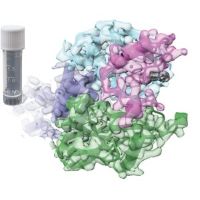Specification
| Description | Recombinant protein from the full-length sequence of Homo sapiens KH domain containing 3 like, subcortical maternal complex member (KHDC3L) (NM_001017361). |
| Organism | Homo sapiens (Human) |
| Expression Host | Human Cells |
| Tag Info | His or DYKDDDDK. Please contact us if you need further information or require specific designed tag. |
| Purity | Greater than 90% by SDS-PAGE gel |
| Uniprot ID | Q587J8 |
| Entry Name | KHDC3_HUMAN |
| Gene Names | KHDC3L C6orf221 ECAT1 |
| Alternative Gene Names | C6orf221 ECAT1 |
| Alternative Protein Names | KH domain-containing protein 3 (ES cell-associated transcript 1 protein) (KHDC3-like protein) |
| Application | Antigens, Western, ELISA and other in vitro binding or in vivo functional assays, and protein-protein interaction studies; For research & development use only! |
| Buffer | Purified protein formulated in a sterile solution of PBS buffer, pH7.2, without any preservatives |
| Endotoxin | Endotoxin level is < 0.1 ng/µg of protein (<1EU /µg) |
| Length | 217 |
| Molecular Weight(Da) | 24306 |
| Protein Sequence | (The sequence of expressed protein may have some variation from the sequence shown below. Please contact us for the exact sequence.) MDAPRRFPTLVQLMQPKAMPVEVLGHLPKRFSWFHSEFLKNPKVVRLEVWLVEKIFGRGGERIPHVQGMSQILIHVNRLDPNGEAEILVFGRPSYQEDTIKMIMNLADYHRQLQAKGSGKALAQDVATQKAETQRSSIEVREAGTQRSVEVREAGTQRSVEVQEVGTQGSPVEVQEAGTQQSLQAANKSGTQRSPEAASKAVTQRFREDARDPVTRL |
Background
| Function | FUNCTION: As part of the OOEP-KHDC3 scaffold, recruits BLM and TRIM25 to DNA replication forks, thereby promoting the ubiquitination of BLM by TRIM25, enhancing BLM retainment at replication forks and therefore promoting stalled replication fork restart (By similarity). Regulates homologous recombination-mediated DNA repair via recruitment of RAD51 to sites of DNA double-strand breaks, and sustainment of PARP1 activity, which in turn modulates downstream ATM or ATR activation (PubMed:31609975). Activation of ATM or ATR in response to DNA double-strand breaks may be cell-type specific (By similarity). Its role in DNA double-strand break repair is independent of its role in restarting stalled replication forks (By similarity). As a member of the subcortical maternal complex (SCMC), plays an essential role for zygotes to progress beyond the first embryonic cell divisions via regulation of actin dynamics (By similarity). Required for maintenance of euploidy during cleavage-stage embryogenesis (By similarity). Required for the formation of F-actin cytoplasmic lattices in oocytes which in turn are responsible for symmetric division of zygotes via the regulation of mitotic spindle formation and positioning (By similarity). Ensures proper spindle assembly by regulating the localization of AURKA via RHOA signaling and of PLK1 via a RHOA-independent process (By similarity). Required for the localization of MAD2L1 to kinetochores to enable spindle assembly checkpoint function (By similarity). Promotes neural stem cell neurogenesis and neuronal differentiation in the hippocampus (By similarity). May regulate normal development of learning, memory and anxiety (By similarity). Capable of binding RNA (By similarity). {ECO:0000250|UniProtKB:F6SZT2, ECO:0000250|UniProtKB:Q9CWU5, ECO:0000269|PubMed:31609975}. |
| Pathway | |
| Protein Families | KHDC1 family |
| Tissue Specificity | Expression appears to be maximal in germinal vesicle oocytes, it tails off through metaphase II oocytes and is undetectable following the completion of the oocyte to embryo transition. {ECO:0000269|PubMed:21885028}. |
QC Data
| Note | Please contact us for QC Data |
| Product Image (Reference Only) |  |

